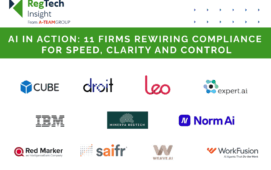By Uri Inspector, Staff Reporter
Corvil’s release last week of its Intelligence Hub propels the Dublin-based data analytics specialist into the burgeoning world of business intelligence for the trading environment. Building on the company’s long-established trading infrastructure monitoring and latency measurement offerings, the Intelligence Hub extracts data from Corvil analytics appliances at every stage in the trading lifecycle to give firms insight into client order behaviour, enhanced transparency into trade performance, and improved compliance through risk management.
Intelligence Hub can be used to generate client intelligence and detect anomalies that help to identify which customers and which aspects of business operations should be attended to, optimised or maintained. The system monitors message flow to assess how customers and counterparties are interacting with the user firm’s trading systems.
“Firms don’t always have the full context to understand what’s happening in their trades and why,” says David Murray, chief marketing and business development officer at Corvil. “Intelligence Hub is a way of giving clients access to that data – to visualise and apply anomaly detection to data points that are of greatest interest to them.”
For Corvil, the platform represents a step from its core infrastructure monitoring offerings toward business analytics, widening the potential audience for its products and services. The scope of its application is broad, Murray says, and the system is being used by early adopters across buy- and sell-side firms from large brokers to hedge funds.
Corvil has orchestrated the Intelligence Hub’s initial roll-out with several early adopter customers, one of which has been using the product for six to eight months. Additional customers will deploy the solution in coming weeks. There are multiple use cases for the platform. “The cases deployed today are quality of execution and client service. We also have a customer using Intelligence Hub for compliance purposes with MiFID II RTS 9,” says Murray.
For example, the system could be used to identify how optimum connectivity to a given execution venue may attract more business from a certain type of customer. Murray explains: “The firm can look at everything from gross notional fill rates, rejects, cancel ratios and symbols, to conclude, for example, that ‘We’re very successful when this customer trades through us with these symbols on that venue or liquidity pool’.” Based on this kind of analysis, the Intelligence Hub user can decide whether to focus more on particular activities to maximise business with a client.
The Hub offers multi-dimensional analysis of transaction lifecycles and outcomes, including customer, symbol, venue, trading session, trading volume, message types, time in force, and others. It can construct detailed venue performance profiles, with data on fill rate by value, volume and fulfilment lifespan, which Corvil says will help improve routing decisions. Its algorithms can reveal missed internal cross-trade opportunities and analysis of disorderly trading behaviours exhibited by execution algorithms or client order flow. It also offers trend and variance analysis of temporal patterns and client order flow metrics such as order frequency and the timing of transactions.
Firms can deploy the Intelligence Hub at one streamable location as a single cluster configuration in a series of nodes. If a firm is using Corvil appliances at multiple venues, it can stream that data back to Intelligence Hub located at one site. The system is priced on an annual subscription service, based on size of the cluster. Larger customers may use multiple clusters or may scale to dozens of nodes while others may begin on three nodes and add nodes as they go.
The product is the result of Corvil’s research into the application of machine learning to machine-time analytics in order to identify and rank key factors in successful order fills. By combining three predictive algorithms, Corvil analysts were able to boost the prediction rate of a successful immediate or cancel (IOC) order to 94% from 30% to 35% at the start of the project. Using machine learning techniques, they were also able to develop quantitative evidence of the role of latency in trading outcomes.
Corvil also looked into the application of machine learning for compliance with MiFID II RTS 9, which governs the ratio of unexecuted orders to transactions. Under the regulation, venues are obligated to designate a maximum Order to Trade Ratio (OTR) for all member flows, which means all members have to make sure they don’t exceed the daily maximum.
Firms need to consistently monitor these ratios, but this is difficult to keep track of, and is most commonly carried out after the fact at the end of the trading day, which does not diminish the risk of the firm having already exceeded venue specific maximums. As a solution to this, Intelligence Hub uses a predictive algorithm that offers data for each asset class and each venue, and can provide venue aligned predictive calculations and measurements of OTR that can reveal by 11am what the end-of-day position would be in terms of OTRs.
Real-time predictive alerts are triggered to warn traders if they are approaching a breach of their limit. Notifications are also given on trading outcomes, infrastructure performance and threat detection, which will also help to stop infrastructure issues and system blocks before they create problems. Intelligence Hub’s multi-dimensional analysis by venue, symbol and transaction type can thus pinpoint risk contributors. Businesses receive alerts based on changes in customer or business behaviours relating to factors such as total business transacted, individual orders, products, conversion or fill rates, and response times.
While Intelligence Hub doesn’t specifically target MiFID II’s best execution requirements for firms to keep records of data for up to five (or seven in some cases) years, it does allow customers to scale out to create a long-term store of data for a variety of purposes including regulatory reporting, as well as secondary reconciliation and trade forensics.
With the MiFID II Systematic Internaliser (SI) regime coming into force in September, and the number of SIs expected to double from 60 to 120 or more, Corvil is looking to SIs as an additional layer of venues and counterparties involved in data analytics. Murray says: “With more pools and more counterparties, it is important to quickly evaluate the effectiveness and identify anomalous performance of one or more of the counterparties. The SI regime will be a contributor to our delivery of anomaly detection.”
Subscribe to our newsletter




